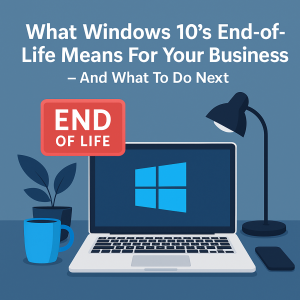 **Windows 10 support ends October 14, 2025. Here’s what it means for your business.**
**Windows 10 support ends October 14, 2025. Here’s what it means for your business.**
Microsoft will officially stop supporting Windows 10 on October 14, 2025. While your computer won’t suddenly stop working after that date, what you will lose is just as important: security updates, feature support, and technical assistance.
If you’re running a business, this isn’t just a technical inconvenience—it’s a security risk, a compliance issue, and a potential productivity killer.
Why This Is a Big Deal for Business Owners
- Security Vulnerabilities:
Once Microsoft ends support, Windows 10 will no longer receive security patches. That means any new malware, ransomware, or other exploit discovered after October 14 will go unaddressed—and hackers know it. Running Windows 10 past this date is like locking your front door but leaving the windows wide open.
- Software Incompatibility:
Many applications will eventually stop supporting Windows 10. You might already notice that some updates are geared toward Windows 11 users. Over time, your favorite apps may stop working or become glitchy, forcing your team to spend time troubleshooting rather than working.
- Compliance Headaches:
For industries with data protection or regulatory compliance requirements (like HIPAA, FINRA, or PCI-DSS), using an unsupported OS could put you at risk of legal and financial consequences. You can’t protect sensitive data if your operating system is no longer secure.
Your Options Moving Forward
Option 1: Upgrade to Windows 11
The most straightforward solution is to upgrade your existing systems to Windows 11. But here’s the catch: not all Windows 10 devices are compatible with Windows 11. It has stricter hardware requirements, like TPM 2.0 and specific processors.
Option 2: Purchase New PCs
If your current machines aren’t compatible, upgrading your hardware is the next logical step. While the upfront cost may seem steep, the long-term benefits in speed, security, and reliability make it worth it.
Option 3: Temporary Fix with Extended Security Updates (ESU)
Microsoft offers a temporary solution called Extended Security Updates, available for a fee or through OneDrive cloud syncing. This will extend security updates for one more year—but it’s not a permanent fix.
Option 4: Alternative Operating Systems
For tech-savvy businesses or specific use cases, switching to Linux is a viable option. But it comes with a learning curve and software compatibility concerns.
Don’t Forget: Back Up First!
Whatever route you take, make sure to back up your data. Use an external drive, cloud backup, or both. An upgrade gone wrong can result in critical data loss if you're not prepared.
Need a Game Plan?
Upgrading dozens (or hundreds) of workstations takes planning. That's where we come in. At First Class Networks, we help businesses audit their current systems, plan for transitions, and minimize downtime.
Want help creating a smart upgrade path? Book your FREE 10-Minute Discovery Call today.



